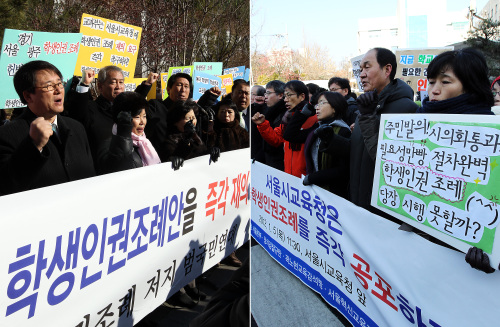Conservatives, progressives clash over controversial ordinance again
The recent school violence cases have sparked controversy again over the student rights ordinance passed in December, which bans corporal punishment and scraps some aspects of the student dress code.
Conservative and progressive teachers have clashed over some issues in the ordinance applicable to all elementary and secondary schools in Seoul, including respect of students’ sexual orientation, pregnancy and childbirth, religion and the right to hold collective protests.
Conservative groups including the Korean Federation of Teachers’ Associations oppose the student rights ordinance, claiming that it fueled school violence in Gyeonggi Province, where it took effect two years ago. They say it obstructs teachers from stopping school violence because it restricts teachers’ right to discipline and punish troubled students.
 |
Civic groups hold separate rallies over the student rights ordinance in Seoul on Thursday, with conservatives (left) and liberals (right) demanding revision and immediate implementation, respectively. (Yonhap News) |
Meanwhile, a progressive teachers’ group, the Korean Teachers and Education Workers’ Union, who welcomed the ordinance, countered the conservatives’ argument, saying that the ordinance will eventually change violent school culture.
However, a middle school teacher in Gyeonggi Province said after the ordinance was approved in 2010 that it has become hard to control students in classrooms, not to mention discipline and punishment. It also made it harder to take effective action against school bullies, said the teacher who asked for anonymity due to the sensitivity of the issue.
She said although teachers and schools take heat for not protecting bullying victims, there’s not much they can do to guide troubled students and discipline them.
“We have no right to control students, but society only holds us responsible for what happened in the classrooms,” she said.
Another middle school teacher in the province also said students become unruly as they believe there are not many things teachers can do to punish them, except for making them write apology letters or consulting with them after school.
“Young students in middle schools have become more freewheeling than ever because they have seen the effects of the student rights ordinance since their freshman year,” the teacher said.
The conservative KFTA claims that school violence has become about 54 percent more frequent since the adoption of the student rights ordinance in Gyeonggi Province. They held a rally on Thursday to demand the ordinance be revised to respect teachers’ right.
A report submitted by the Gyeonggi provincial education office to its municipality show that middle school students make up 85 percent of total student bullies in the region, up by 8.5 percent from 2010 with 837 school violence reported.
In the wake of school violence, the progressive teachers’ group has not expressed an official position on school violence yet.
The head of the group, Jang Seok-woong, said a fundamental change in schools should come first in order to prevent school violence.
“Schools should not place good grades before character education, and if schools are not reformed, school violence measures will end up as another one-time fix,” Jang said at an open forum on school violence on Wednesday.
Kim Hyoung-tae, a Seoul councilor who proposed the student rights ordinance last month, said associating student rights ordinance with school violence is an irrational interpretation.
“The root problem in school violence is an overly competitive system. Students stressed out by fierce competition tend to bully their peers who seem weaker than them. We need to find out the cause of school violence and try to resolve it together and not blame each other,” Kim said.
“School violence has always been in school community before the student rights ordinance was passed.”
By Lee Woo-young (
wylee@heraldcorp.com)





![[Exclusive] Hyundai Mobis eyes closer ties with BYD](http://res.heraldm.com/phpwas/restmb_idxmake.php?idx=644&simg=/content/image/2024/11/25/20241125050044_0.jpg)
![[Herald Review] 'Gangnam B-Side' combines social realism with masterful suspense, performance](http://res.heraldm.com/phpwas/restmb_idxmake.php?idx=644&simg=/content/image/2024/11/25/20241125050072_0.jpg)

